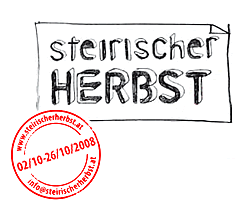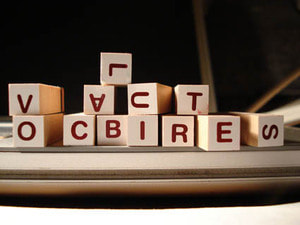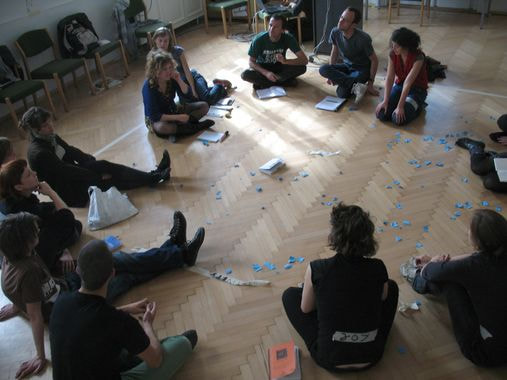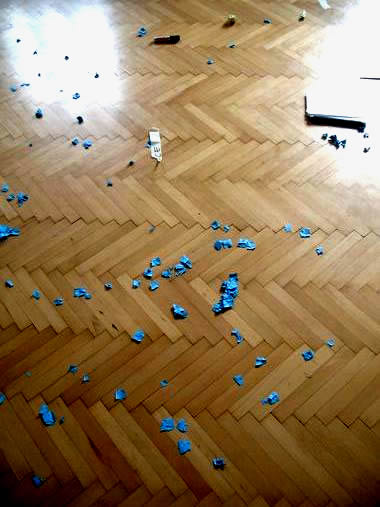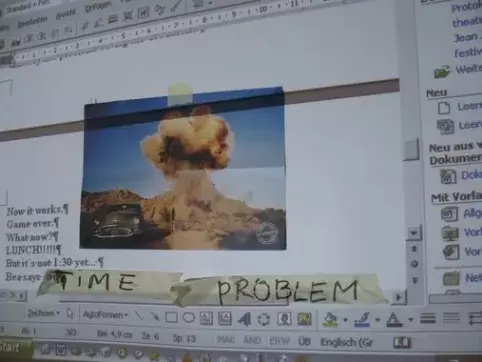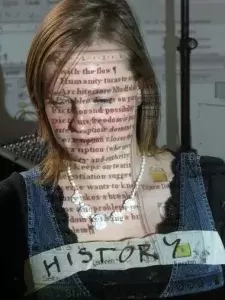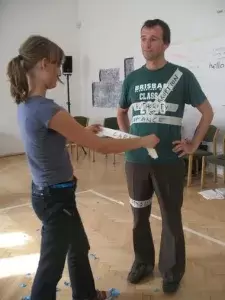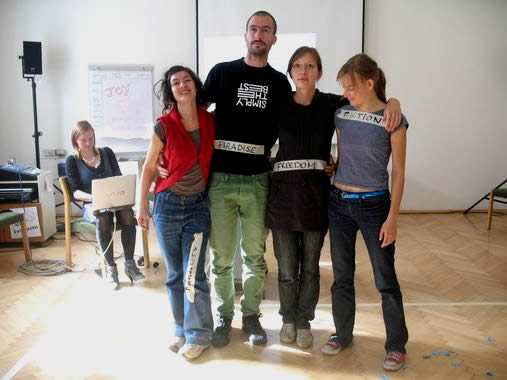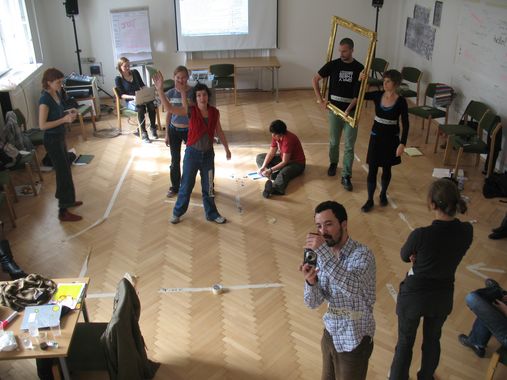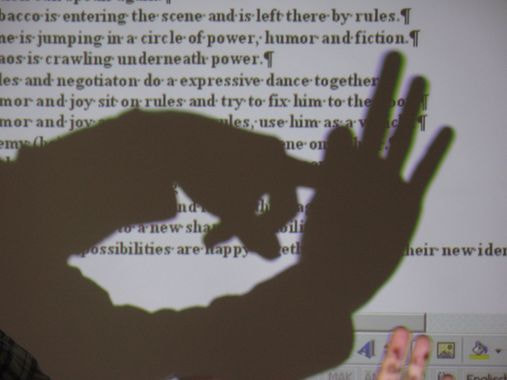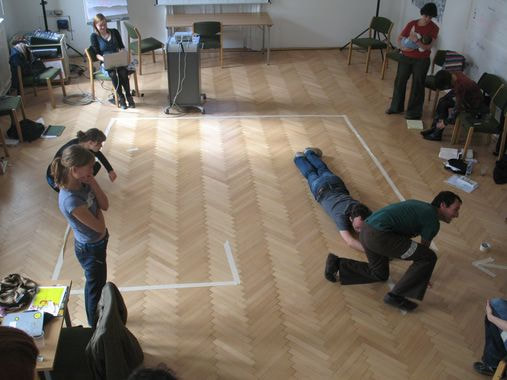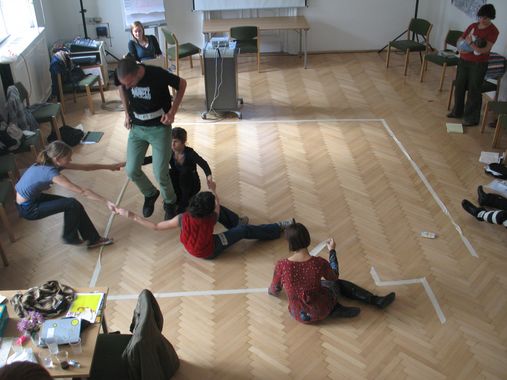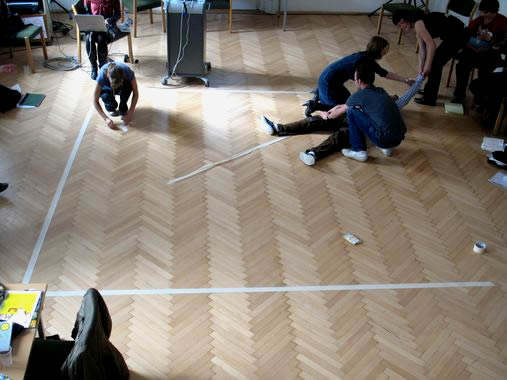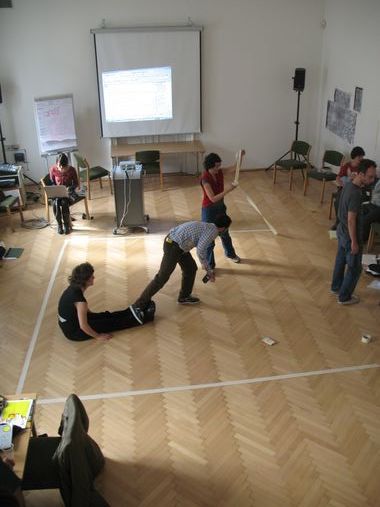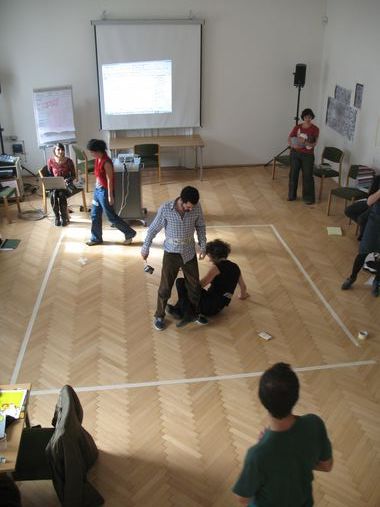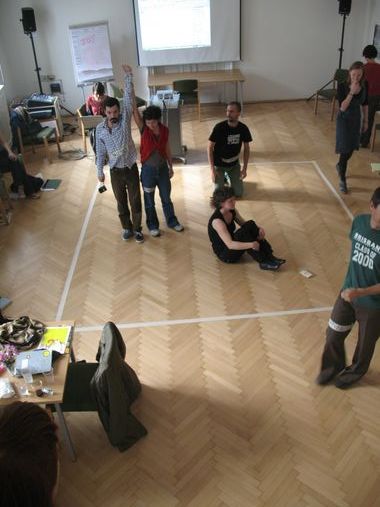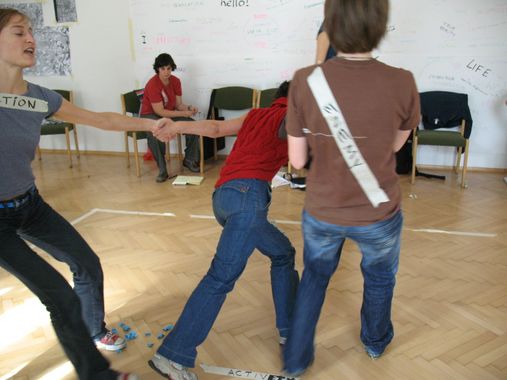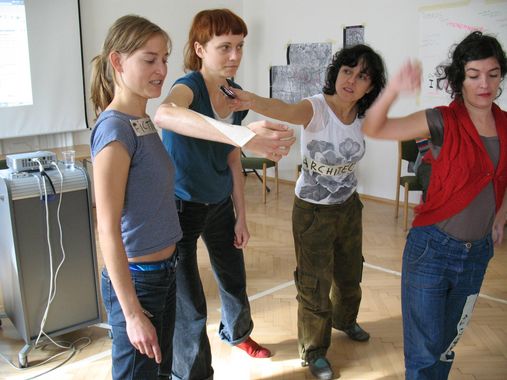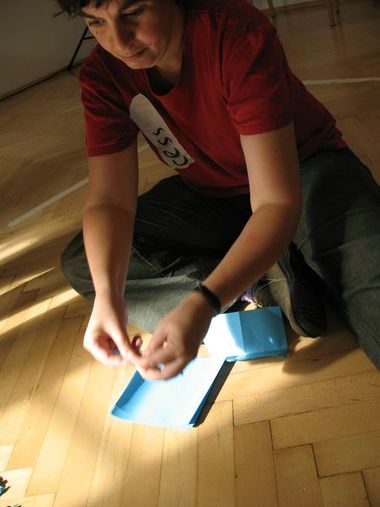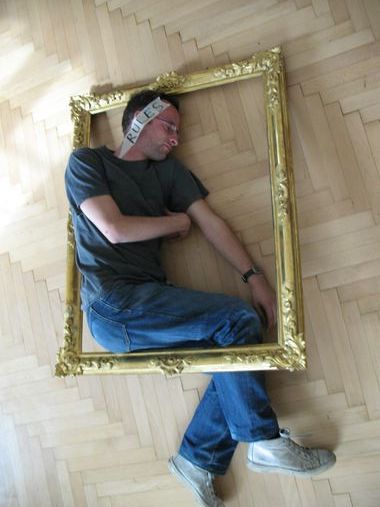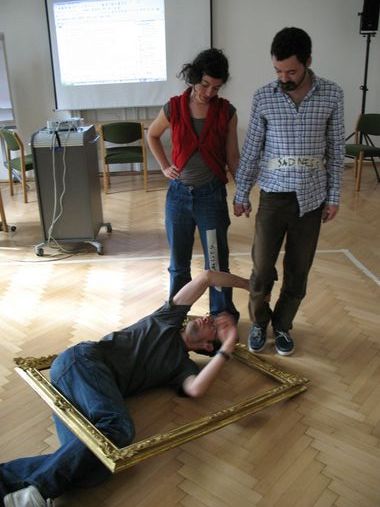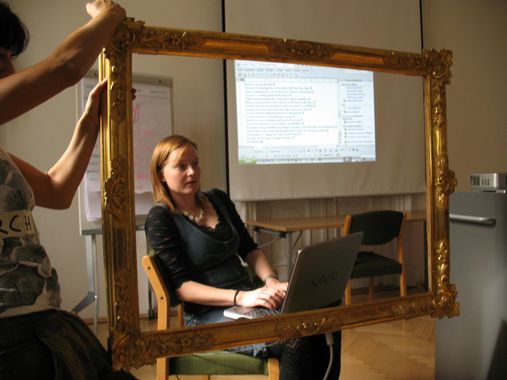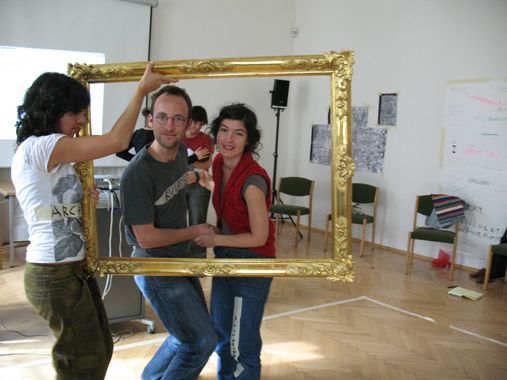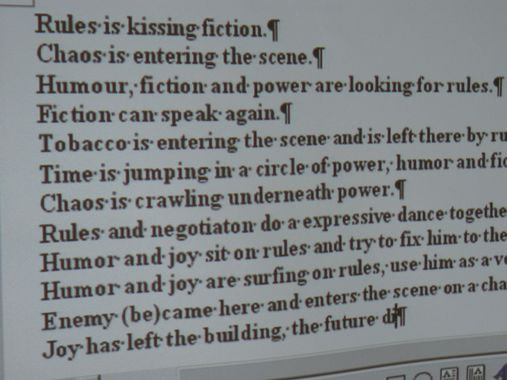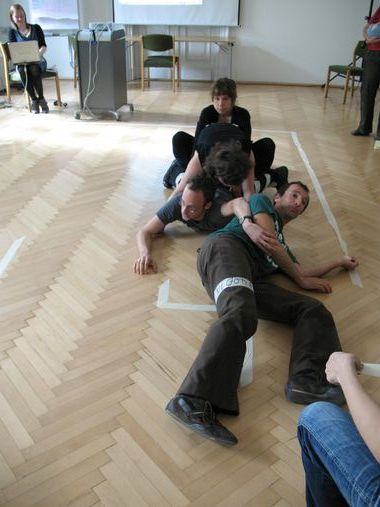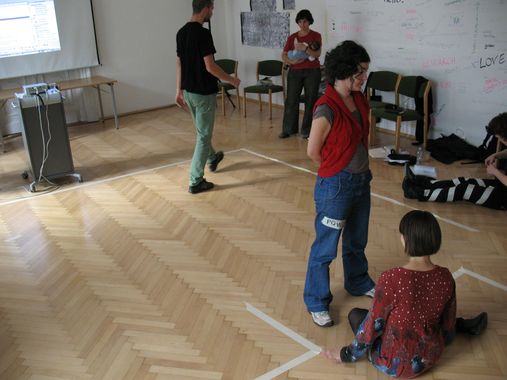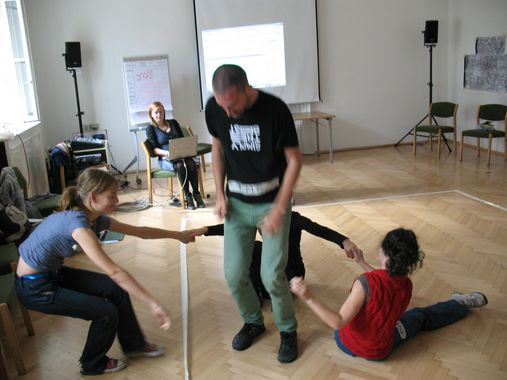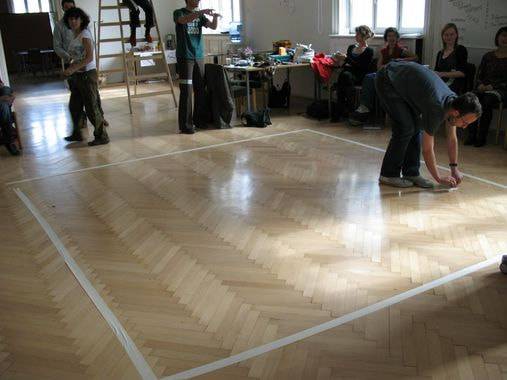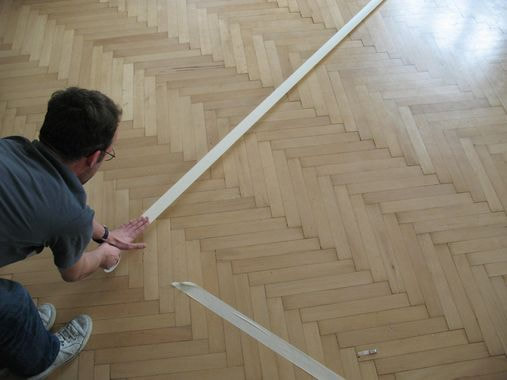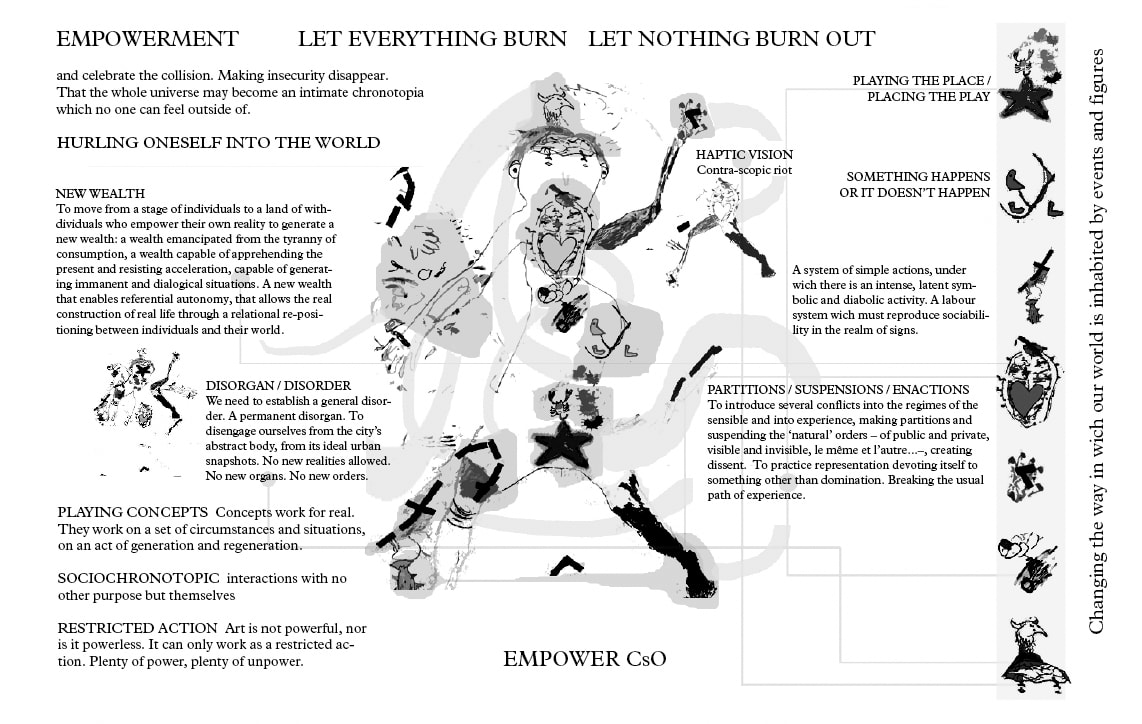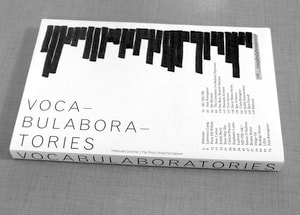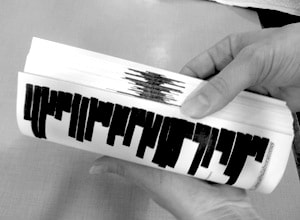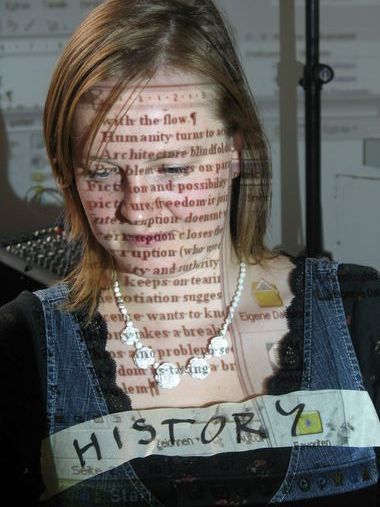Empower CsO
Steirischer Herbst – Vocabulaboratories · 2008
Taller / Workshop invitados por Vocabulaboratories (Paz Rojo y Manuela Zechner) junto con Judith Revel.
Lucie Eidenbenz / Valeria Graziano / Joa Hug / Andrea Maurer / Eva Meran / Guillem Mont de Palol / Esther Muschol Tor Navjord / Aleksandra Pavlovic / Luise Reitstätter / Franziska Roehlig / Paz Rojo / Kathrin Schaefer / Daphna Weinstein David von Westphalen / Manuela Zechner / Susana Velasco / Rafael Sánchez-Mateos Paniagua
|
[ empowerment ]
HAVE YOU EVER FELT POWERFUL? what it’s being said Empowerment is a process of transition from a state of powerlessness to a state of control over one’s life, destiny, environment etc. It is a multidimensional process. Psychology, economics, technology… they have appropriated the term in their discourses. Bill Gates talks about empowering tech, yoga talks about empowering oneself, women become empowered in their reality, Adbusters sell an empowerment media kit, squats empower their districts with their social labs, economics talk about empowerment banking practices… All of them have produced a specific meaning of empowerment in terms of achieving control, achieving influence or domination, which has been developed into an immense catalogue of know-how strategies. In fact, it seems as if words such as freedom, justice, liberty, brotherhood, equality have been hidden behind ‘empowerment’. It sounds techie, it sounds new, it sounds different… social framework The social framework have quickly adopted the notion of empowerment. In fact, social sphere and public sphere are the sites where empowerment empowers its strongest meaning; the concept has in fact settled down where life grows. In this sense, social meanings, social processes, social configurations and social conflicts will be a nuclear item when talking about empowerment. playing concepts / idea’s work We are not going to propose ‘a new meaning of empowerment’. We prefer to look for the signs and movements that it produces, its effects. Something happens or doesn’t happen. We wonder which is the best way to test a concept from this immanent standpoint. When using the term immanence, we avoid the discussion around the concept. This immanence leads us to concentrate in the word’s operations, in its work. Ideas work. Concepts work for real. They work on a set of circumstances and situations, on an act of generation and regeneration. An efficient proposal in this sense would be an approach to these ideas with the aim of playing concepts, as a ludic form or an instrument, finding their immanent work. Here and now. Finding a strategy (or maybe a tactic?) with which to move concepts from the deep sea of theory into a context of an efficient practice that maintains their force. vocabulaboratory In the Vocabulaboratories framework, we would like to propose thinking about the relationships between empowerment, culture and artistic practice. How empowerment can be understood in an aesthetic way, and therefore, in a way of thinking our (all of us, artists, who think that art is capable of participating in politics critically and efficciently) performative work and its social experience. The question is how the artwork and the aesthetic experience can concern the political. old school art discourses Maybe the old dichotomy between the Marxist and the autonomous art discourses must be overcome. On the one hand, there is the research of an autonomous art status that encloses and confines its interests to itself in order to produce the big formal revolutions (now hanging on museum walls); on the other, an art practice which works alongside the political project of a transformation of life, allowing itself to be led by a projection of a radical utopia on it. restricted action When talking about art and utopia, we should remember that the solution for this binomial myth shouldn’t be sought in terms of ‘all’ or ‘nothing’ (the All of the utopian accomplishment, the Nothing of the artist enclosed in himself). If only we work based on a restricted action (remembering Mallarmé) in the artwork context, we could be able to solve this impasse. Art is not powerful, nor is it powerless. It can only work as a restricted action. Plenty of power, plenty of unpower. Efficient and sufficient. partitions / suspensions / enactions With Rancière, we can say that if art concerns politics, it is because art introduces several conflicts into the regimes of the sensible and into experience, making partitions and suspending the ‘natural’ orders (of public and private, visible and invisible, le même et l’autre…) creating dissent and discovering anomalies in them. The artwork would then stand for dissent. Not just for a critique of the discourses of control; [but] for a practice of representation that devotes itself to something other than domination… working towards a practice of empowerment that searches for new skills andenactions (as Mignolo says) capable of bursting into the conversation between feeling and thinking the world, and producing an understanding of the world where it appears as this space plenty of singular, inconsistent and multiple beings, a place where thought does and action thinks. In this sense, the artwork can change the forms of enunciation through “changing scales, frames, rhythms, or building new relationships between appearance and reality, individual and common, the visible and its meaning”, generating a permanent disorder and a constant dis-organ. When our perception of sensible events changes, it changes our relationships with people (our social constructions) along with it, changing also the way in which “our world is inhabited by events and figures”. disorder and disorgan Rancière reminds us of the effects that our work can provoke. We can transmit messages, offering models or contra-models of behaviour, or learning how to decode representations. We can also “arrange bodies on singular space-times, defining ways of being together or separated, in front of or in-between, inside or outside”. (Thus identifying artistic and political forms directly with one another, at the risk of bringing both to their disappearance). Finally, there is a third option (there is always a third pill…, as Zizek reminds us), which is working for dissent : empowering of one’s own reality and breaking the usual path of experience (the social, cultural, economic, political, physical-psychological ones…), opening new possibilities of interchange in its structure and social condition, and not only in the limits of the sensible. At this point we find a great power on producing the real in order to transform reality. Hic et nunc. Not before, nor after revolution: things happen meanwhile. So let’s infiltrate our disorder where this scene takes place… IF YOU HAVE FELT POWERFUL WAS IT AT SOMEONE’S EXPENSE? power of individual Empowerment is about Power, but Power doesn’t exist in isolation. Power grows in-between. It grows in the social interstice of human relationships. It’s not inherent in positions or people. It’s not a question of individuality or character. Powers exist in movement, circulation, traffic, smuggling… powers can change position, situation, strategy. In a certain way, Power can be understood differently, depending on the positions it adopts in the general structure. Power could grow where we didn’t imagine; inside the space-time playing of a crowd, at a crossroads or in the center of boredom. We could also imagine power growing in some particular new way: outside the sphere of domination, without the usual power relationships, those which open the doors to insecurity and fear, without the statement of the individual… IF YOU HAVE FELT POWERFUL WAS IT WITH SOMEONE? powers of withdividualsEmpowerment attempts to connect the personal and the social; connecting the individual and the communal, not in an organic-biological way, nor systemic-mechanical.The interstice is the place where the social is configurated. It is where relationships find their sphere of operation and redefinition. To work in the public sphere is not about working outdoor or working transparently to the rest of the world. To work in the public sphere means that our artwork has the will and intent to operate and participate in that interstice, allowing the emergence of new relationships with and between signs, bodies, objects, or people , in order to propose dissent from the hegemonic state of experience. To generate fractures. The work is not about social life, but in social life; this is what practice is in its essence. Theory cannot make much, unless we induce a movement upon it, unless we start playing theory. Problems used to be solved theoretically, but problems are just problems (said Manuel Delgado). new wealth To be able to find solutions, not necessarily together, but for togetherness – the common. To move from a stage of individuals to a land of withdividuals who empower their own real and reality to generate a new wealth: a wealth emancipated from the tyranny of consumption, a wealth capable of apprehending the present and resisting acceleration, capable of generating immanent and dialogical situations. A new wealth that enables referential autonomy, that allows the real construction of real life through a relational re-positioning between individuals and their world. At this point the whole universe becomes an intimate chronotopwhich no-one feels outside of: hurling oneself into the world and celebrating the collision. let everything burn. let nothing burn out. |
What HERSTORY said about this event:Activity sits down
Future is here Process in ling in the space Rules is claping Enemy is behind sadness Humanities is giving rithem to rules Wisteling by sadness Process is smiling NegotioaTION GIVING HANDS TO POWER Humour is slipping Sadness kissing humour Rules enter the room History is here Future is ling on the floor I’m very sad I<#m very sad I<#m very sad I#m very sad I’M very sad Humour was thinking Humour observed architecture manipulating rules Rules is making an entry point as well as framing the space where the entry should happen Chaos is trying to documnt Rules plays around History will assist chaos documentating Process is two in one. Time is joing proces. Joy doesn’t seem welcome. Sadnes is questioning her. Time is very close to process. Power enters. More power for sadness. Power is opening the space or better changes it. Sadness is ill and rules and history help. Fiction is standing in the corner. Rules is kissing fiction. Chaos is entering the scene. Humour, fiction and power are looking for rules. Fiction can speak again. Tobacco is entering the scene and is left there by rules. Time is jumping in a circle of power, humor and fiction. Chaos is crawling underneath power. Rules and negotiaton do a expressive dance together. Humor and joy sit on rules and try to fix him to the floor. Humor and joy are surfing on rules, use him as a vehicle. Enemy (be)came here and enters the scene on a chair. Joy has left the building, the future disappears. A bit of activity is showing up on stage. Futere becomes freedom and leaves the stage. Power transforms to a new shape: possibilities. Freedom and possibilities are happy together and with their new identities. Chaos enters the stage and changes the borders by writing on them. Negotiation is calling the rules back to mind. Architecture brings a shape to history. Possibilities is taking of the meaning of rules, the rules are gone and framed by architecture. Sadness is entering the frame and helps the rules to activate themselves. The rules have changed into a problem. Sadness is framing the documentation, humor takes over the frame. Time is in the frame (great!) Possibility announces that fiction will describe a performance possibility will enact. Negotiation enters the stage to limit the overbording events on stage, trying to organize a structure. Leaving on stage: architecture, the new enemy, flow, possibilities, it´s a little hard to keep an overview… Humor is doing the storytelling, by the way. Possibility is struggling with two other people, negotiagion intervenes to keep it from becoming violent. Possibility suggests, that negotiation shouldn´t worry about this but go with the flow. Humanity turns to acceptance. Architecture blindfolds paradise. Problem hangs on paradise, then falls down. Fiction and possibility take the blindfold off from paradise, they pose for a group picture, freedom is joining them. Interruption doensnt wantfotographs to be taken. Interruption closes the eyes of history, histroy is writing anywaysj. Interruption (who used to be negotiation before) now turns also into acceptance and capacity and authority. Process keeps on tearing papers to pieces and throwing them on the floor. The negotiation suggest that everybody now does what he wanted to do or not. Innocence wants to know why history wants to document everything. History takes a break. Chaos and problem seem to be friends, paradise is very close to them. Freedom is taking a break and relaxing. Problem is approaching history. History has problems saving the document. Now it works. Game over. What now? LUNCH!!!!! But it´s not 1:30 yet… Bea says goodbye to everyone and thanks us for being such a great group. Clapping. People say goodbye to Bea. Some people crap their identities, others leave it, Paz adds a blanc identity card to her pants – no, it´s not staying blanc, she turns into ??? History is annoyed by not being able to change her point of view because of technical devices. Maybe someone can tell her? Now she sees: Paz turned into crisis. Alright, activity tells history, that it´s time to leave the computer, architecture wants to do some more documentation (isn´t that the role of history?), so history keeps on writing. Process also starts documenting, what am I doing here??? Game over now. Finally. The end. |
